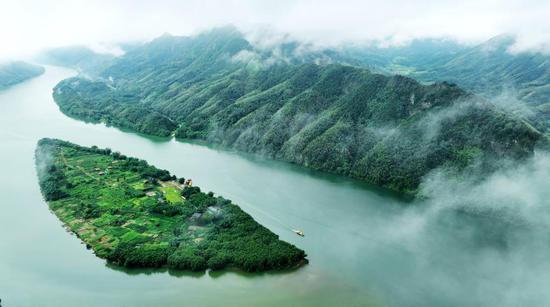The Qinghai-Tibet Plateau, one of China's most crucial ecological security barriers, is becoming warmer, wetter and greener, and the warming climate and increased humidity is leading to significant imbalances, according to the findings of a latest research.
The imbalances on the plateau, which is also known as Asia's "water tower", are primarily manifested in the rapid reduction of solid water bodies such as glaciers alongside a widespread increase in liquid water bodies such as lakes and rivers, said researchers on Sunday during a news conference held in Lhasa, Xizang autonomous region, related to the second scientific expedition and research in the Qinghai-Tibet Plateau region.
They said the implementation of a series of key ecological projects has curbed the rampant degradation of the plateau's ecosystem and improved its overall stability, with the discovery of over 3,000 new species in the past 15 years. However, the plateau is expected to enter a "super warm and humid phase" by the end of this century, they warned.
Climate models predict that by the end of the century, some regions could lose more than half of their glacier mass, with lake water levels potentially rising by over 10 meters, according to the researchers.
While this phenomenon could enhance the overall water supply capacity, the risks of glacier collapses and glacial lake outburst floods are projected to be more than three times higher than current levels.
Therefore, it is essential to strengthen the construction of early warning systems for glacial collapses and glacial lake outbursts, and implement more effective measures for sustainable water resource management, they said.
Yao Tandong, an academician at the Chinese Academy of Sciences and head of the scientific expedition, said the plateau is experiencing a combination of warming, increased moisture, greening of vegetation, and a concerning "darkening phenomenon".
The phenomenon stems from the reduction in glacier areas and snow cover, coupled with the greening of vegetation, leading to a decrease in surface albedo, or the fraction of light reflected by a surface.
"Such changes could lead to significant shifts in the Asian monsoon circulation, potentially increasing the frequency of extreme weather events in China," Yao said.
With more than 100,000 square kilometers of glaciers and 1 million sq km of frozen soil, the plateau — often referred to as the "roof of the world" and the "third pole of Earth" — serves as the source of 10 major Asian river systems flowing into 10 countries, and supports the lives of about 2 billion people.
It currently stores more than 10 trillion cubic meters of surface water, roughly equivalent to the total runoff of the Yellow River over 200 years, and the impacts of the climate-induced imbalances on its ecosystem are becoming increasingly apparent, Yao said.
These imbalances manifest as disruptions in both solid-liquid phase equilibrium and the spatial distribution of water resources, underscoring the need for regional strategies and international cooperation to effectively address the challenges, he said.
The warming climate has already spelled disaster for Northwest China's Xinjiang Uygur autonomous region, where the total glacier area has decreased 11.7 percent, with the reduction rates in different regions varying from 8.8 percent to 34.2 percent.
Amid this grave situation, the Qinghai-Tibet Plateau holds immense ecological significance as a crucial ecological security barrier and strategic resource reserve.
The second scientific research was launched in August 2017, and focuses on ecological protection and sustainable development of the plateau region. A total of 2,600 teams involving 28,000 personnel carried out scientific research across the plateau to safeguard the local ecosystem.
The scientific insights gained during the expedition have helped accelerate legislative efforts for local ecological protection. Proposals such as enhanced glacier monitoring, disaster preparedness and the preservation of ecological barriers have been integrated into national legislative frameworks, highlighting the expedition's impact on policy formulation.
A regulation on safeguarding the glaciers of Xizang, which will take effect on Oct 1, will be a milestone in the region's formulation of legislation for ecological protection, Xinhua News Agency reported.
The regulation aims to implement a system of fixing accountability, assessing performances for achieving glacier protection objectives, and introducing penalties for violations.
Zhao Guiying, deputy director of the legislative affairs commission of the Standing Committee of the People's Congress of Xizang, said the regulation will play a crucial role in safeguarding glacier resources and ensuring the ecological well-being of the plateau.
It follows the September 2023 enactment of China's law on ecological conservation of the Qinghai-Tibet Plateau, which was the first national-level legislation tailored to oversee ecological conservation efforts on the plateau.


















































 京公网安备 11010202009201号
京公网安备 11010202009201号